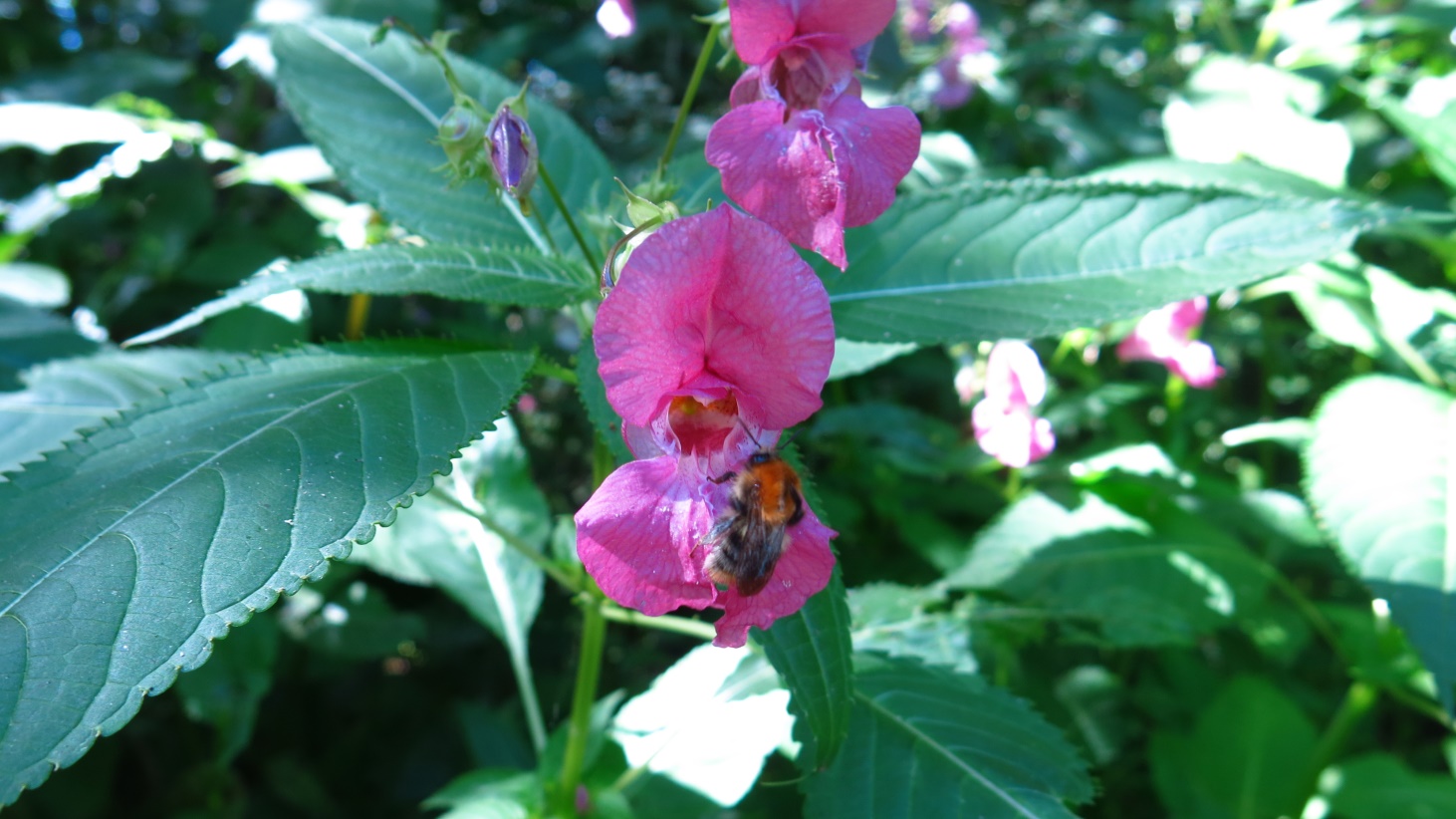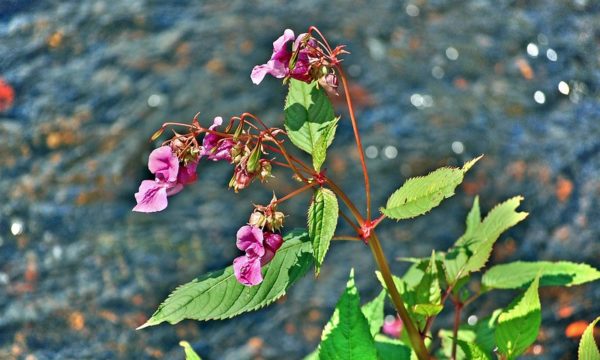In November and December 2015 the following datasheets were published on CABI’s Invasive Species Compendium (ISC). You can explore the open-access ISC here: www.cabi.org/isc.
Cotoneaster horizontalis (wall-spray)C. horizontalis is a woody, perennial, deciduous or semi-evergreen shrub with horizontally spreading branches, native to parts of China. It is an attractive garden plant with bright red berries which is the main cause for its widespread introduction across the world. In addition to keen gardeners, seeds of this plant are spread easily by birds. Unfortunately, it invades chalk grasslands (such as those of the South Downs in the UK), reducing species richness and diversity.
Cyperus papyrus (papyrus)C. papyrus is a tall (up to 5 m), fast-growing, aquatic perennial sedge native to North Africa, well-known as being a source material for the making of paper (papyrus). Plumes of thread-like stems at the top of the plant make it particularly attractive and have resulted in its use as an ornamental plant and consequently its introduction to other countries. It can anchor itself in water via shallow roots or floats freely in clumps, facilitating its spread. The dense and extensive stands it can form can impede the flow of waterways and displace native species. It can reduce the amount of light that reaches submerged plants and can impact on habitats of wetland bird species.
Myroxylon balsamum (Peru balsam)
M. balsamum is a large tree of tropical America (40-45 m tall and 1 m wide) which produces lots of small whitish flowers and winged seedpods. Providing valuable timber and balsam resin, it has been widely introduced. It can form dense stands and can therefore outcompete native species by shading them. Characteristics which make it such a strong competitor include its large size, capacity for prolific seed production and ability to tolerate a wide range of light conditions. It is particularly problematic in Sri Lanka where native species can tolerate less varied light conditions and where natural enemies, such as diseases and insects, are absent.
Persicaria wallichii (Himalayan knotweed)P. wallichii is a shrubby perennial herb that originates from the temperate western regions of Asia and the Indian subcontinent. It is reported as invasive in its native range of India and its non-native range of Belgium and the UK. In the USA, it can promote the erosion of river banks where it pushes out native stabilizing species, colonizes large areas, but then dies back in the winter. Furthermore, the dense mats of leaf litter it produces can prevent the germination of native species. It can compete for resources with trees and reduce shade along rivers and streams by displacing native woody species.
Roystonea oleracea (Caribbean royal palm)
R. oleracea is a palm that grows up to 40 m tall, with a distinctive, solitary, light grey, erect, cylindrical trunk. It is native to the Lesser Antilles, northern South America and Guatemala. This invasive species has been widely introduced for ornamental and landscaping purposes. It tends to be invasive in or near wetlands and can reduce diversity in areas where it becomes dominant. The dropping of large leaves and reproductive parts, which alter light intensity and humidity, have been proposed as possible reasons for these impacts. It is reported to be invasive in the swamps of the Guiana shield countries, in Panama and in the Atlantic forests of southern Brazil.
Urtica dioica (stinging nettle)U. diocia is a weedy species which, as many people know from experience, has hairs which can cause an itchy sting when touched. It occurs in pastures and grasslands in monospecific clumps which can take up considerable space and thus reduce hay yields and the amount of grass available. It is normally avoided by livestock, therefore restricting their free movement. In some circumstances it can be very hard to eradicate because of its large root mass which allows it to spread vegetatively once it has established.
Other new datasheets published in November and December include:
Acacia glauca (wild dividivi)
Argemone ochroleuca (Mexican poppy)
Canine distemper virus
Centella asiatica (asiatic pennywort)
Deroceras invadens (tramp slug)
Flacourtia indica (governor’s plum)
Portulaca quadrifida (chickenweed)
Solanum capsicoides (cockroach berry)
Tephrosia candida (white tephrosia)
Xyris complanata (yellow-eyed grass)
Figure references:
- Cotoneaster horizontalis by peganum from Henfield, England (Cotoneaster horizontalis) [CC BY-SA 2.0 (http://creativecommons.org/licenses/by-sa/2.0)], via Wikimedia Commons
- Cyperus papyrus by By Liné1 (Picture taken with my IXUS 800 IS) [GFDL (http://www.gnu.org/copyleft/fdl.html) or CC BY-SA 3.0 (http://creativecommons.org/licenses/by-sa/3.0)], via Wikimedia Commons
- Persicaria wallichii by By Meneerke bloem (Own work) [GFDL (http://www.gnu.org/copyleft/fdl.html) or CC BY-SA 3.0 (http://creativecommons.org/licenses/by-sa/3.0)], via Wikimedia Commons
- Roystonea oleracea by By Krzysztof Ziarnek, Kenraiz (Own work) [CC BY-SA 4.0 (http://creativecommons.org/licenses/by-sa/4.0)], via Wikimedia Commons
- Urtica dioica by By Meneerke bloem (Own work) [GFDL (http://www.gnu.org/copyleft/fdl.html) or CC BY-SA 3.0 (http://creativecommons.org/licenses/by-sa/3.0)], via Wikimedia Commons
Related News & Blogs
CABI and Malawi Government publishes guide to the naturalized and invasive plants of Malawi
CABI has published a ‘Guide to the Naturalized and Invasive Plants of Malawi’ – a country home to the UNESCO World Heritage site, Lake Malawi, the fifth largest freshwater lake in the world by volume and home to around 700 species of cichlids. The guid…
13 May 2024

![By peganum from Henfield, England (Cotoneaster horizontalis) [CC BY-SA 2.0 (http://creativecommons.org/licenses/by-sa/2.0)], via Wikimedia Commons](https://cabiinvasives.files.wordpress.com/2016/01/cotoneaster_horizontalis.jpg)
![By Liné1 (Picture taken with my IXUS 800 IS) [GFDL (http://www.gnu.org/copyleft/fdl.html) or CC BY-SA 3.0 (http://creativecommons.org/licenses/by-sa/3.0)], via Wikimedia Commons](https://cabiinvasives.files.wordpress.com/2016/01/cyperus_papyrus.jpg)
![By Meneerke bloem (Own work) [GFDL (http://www.gnu.org/copyleft/fdl.html) or CC BY-SA 3.0 (http://creativecommons.org/licenses/by-sa/3.0)], via Wikimedia Commons](https://cabiinvasives.files.wordpress.com/2016/01/persicaria_wallichii.jpg)

![By Frank Vincentz (Own work) [GFDL (http://www.gnu.org/copyleft/fdl.html) or CC-BY-SA-3.0 (http://creativecommons.org/licenses/by-sa/3.0/)], via Wikimedia Commons](https://cabiinvasives.files.wordpress.com/2016/01/urtica_dioica.jpg)



